- Home
- Technical Cooperation Projects
- Index of Countries
- Asia
- Nepal
- The Project on Participatory Rural Recovery
- Project News
- About Our Pilot Locations (Part 1) Barpak-Sulikot Rural Municipality, Gorkha District
Project News
2020-12-04
About Our Pilot Locations (Part 1)
Barpak-Sulikot Rural Municipality, Gorkha District
The Project on Participatory Rural Recovery (PPRR) has been operating in the 4 pilot locations - 2 urban municipalities and 2 rural municipalities - in Gorkha District and Sindhupalchowk District which were most severely affected by the Nepal Earthquake that occurred in April 2015. Through this series of Project News, we would like to introduce you to some of the unique and fascinating features of these pilot areas.
Barpak-Sulikot Rural Municipality (hereinafter referred to simply as ‘Barpak') is located northwest of the capital city Kathmandu. It takes about 8 hours from Kathmandu to Barpak which is now widely known as the epicentre of the Nepal Earthquake. The first four hours of the car ride is on a major paved highway running from Kathmandu to the western parts of the country, but the second half is a bumpy ride on mostly unpaved dirt roads that often become too muddy and non-motorable during the rainy season.
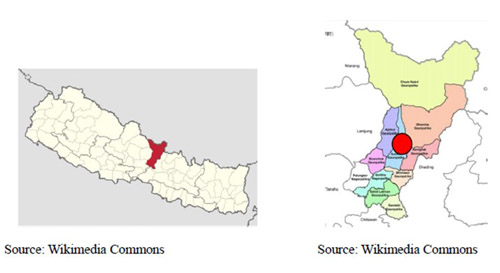 Left: Location of Gorkha District in the map of Nepal
Left: Location of Gorkha District in the map of Nepal
Right: Location of Barpak-Sulikot Rural Municipality in the map of Gorkha
*The red circle is added on the original data by author
The central bazaar area of Barpak is located at approximately 2,000 meters above the sea level. On a fine day, you can have magnificent views of the Buddha Himal (6,692m) of the Himalayas right in front of you. Barpak is also known as a starting point of the trekking route to the Manaslu circuit, and many Nepali trekkers and tourists visit the village to enjoy the scenic views of the mountains and the natural environment, and to experience the traditional lifestyle of ethnic groups in the mountain regions.
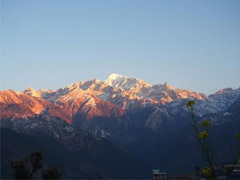 Grand views of the Himalaya mountains seen from the village centre.
Grand views of the Himalaya mountains seen from the village centre.
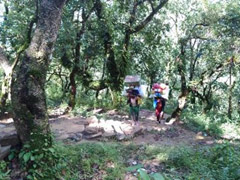 People carry uphill their daily necessities on their heads.
People carry uphill their daily necessities on their heads.
Almost 70% of people in Barpak-Sulikot Rural Municipality belong to the Gurung tribe, one of the Tibetan ethnic groups. Therefore you can clearly see a strong influence of the Tibetan culture and tradition in people's lifestyle and landscapes. This mountainous area of Gorkha used to have many picturesque sceneries of houses and streets built with black stones and attracted a number of tourists. However, as the traditional stone structures were not seismic resilient, unfortunately, most of the traditional houses and walls collapsed when the earthquake hit. Thus, the historic, beautiful landscape in Barpak, which was one of the main attractions for tourists visiting the area, was also lost.
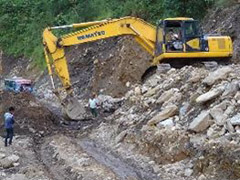 The journey to Barpak is still difficult, despite the steady progress in road construction and expansion in recent years.
The journey to Barpak is still difficult, despite the steady progress in road construction and expansion in recent years.
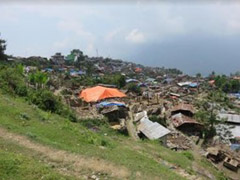 Barpak village near the epicentre, soon after the earthquake.
Barpak village near the epicentre, soon after the earthquake.
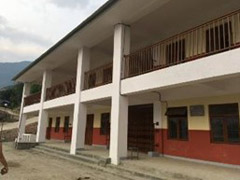 The new secondary high school buildings in Barpak were reconstructed by JICA assistance.
The new secondary high school buildings in Barpak were reconstructed by JICA assistance.
Barpak experienced significant damages by the 2015 earthquake, including about 7,000 houses either completely or partially destroyed, and 140 school buildings severely damaged. JICA has assisted post-earthquake reconstruction by providing technical know-how for ensuring seismic standards for housing and school reconstruction.
Now, five years after the earthquake, as much as 95% of the houses in Barpak have been rebuilt, and many children are able to study in their new classrooms. Shree Himalayan Higher Secondary School is one of such newly rebuilt schools in Barpak. Students shared their joy by saying that they are no longer afraid to go to school while they used to fear every day that another earthquake might happen and destroy their temporary classrooms. People in Barpak are continuing their efforts every day to rebuild their own communities to be resilient against disasters. JICA has also provided assistance for their livelihood recovery.
- [Video] JICA's Five Years of Building Resilient Nepal (external site)
- [Video] Women in Charge: Livelihood Recovery after Nepal Earthquake (external site)
In Barpak, 80% of the population is engaged in agriculture, and the majority of the farmers are conducting family-based, subsistence-level agricultural practices. In this context, many young men choose to work abroad as migrant labourers while only women, children and the elderly remain in the villages, which was among the challenges for Barpak's development even before the earthquake.
Post-earthquake recovery does not end with making strong buildings that would withstand earthquakes. We must also transform the village economy that was negatively impacted by the earthquake into a sustainable structure which will provide people with economic stability and overall wellbeing in a long-term. Therefore, one of the pillars of the Project will be to support people in Barpak in addressing issues related to their economic recovery. Such efforts will include exploring new ways of tourism promotion after the earthquake, and creating and diversifying marketable products from the area.
Through the website, we will update on the activities in Barpak as we move forward. Please stay tuned!
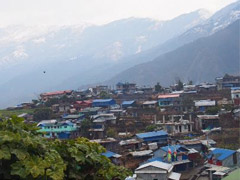 Reconstruction has been making steady progress in Barpak.
Reconstruction has been making steady progress in Barpak.
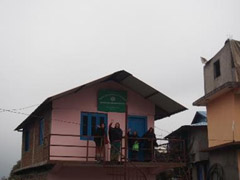 Villagers waving at project staff.
Villagers waving at project staff.
- About JICA
- News & Features
- Countries & Regions
- Our Work
- Thematic Issues
- Types of Assistance
- Partnerships with Other Development Partners
- Climate Change / Environmental and Social Considerations
- Evaluations
- Compliance and Anti-corruption
- Science and Technology Cooperation on Global Issues
- Research
- JICA Development Studies Program / JICA Chair
- Support for the Acceptance of Foreign HRs / Multicultural and Inclusive Community
- Publications
- Investor Relations
